Top News
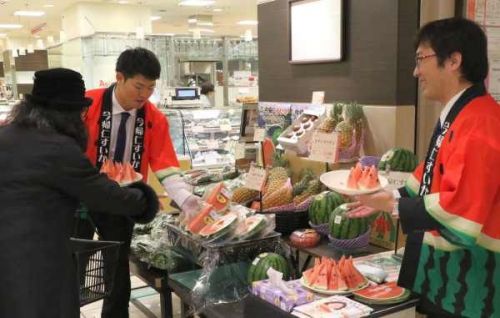
January 17, 2020 Ryukyu Shimpo
Tokyo – On January 15, JA Okinawa held a tasting and promotional event in Tokyo to increase awareness of Japan’s earliest watermelons, Nakijin watermelons, outside of Okinawa.
Workers promoted and provided tastings of winter watermelons to consumers, beginning the day in the early morning with brokers at Toyosu Market and moving in the afternoon to Takashimaya in Tamagawa.
Customers, mouths full of watermelon, called the watermelons in winter “unusual” and described the taste as “sweet and delicious.”
They were eager to buy Nakijin watermelon.
The JA Okinawa Nakijin House Watermelon Production Subcommittee is a group of 23 people.
Yusaku Toyozato is the committee chair.
He says, “Starting in April, we will participate in the Hometown Tax Donation program.
We will work to rebuild our brand by focusing on flavor.”
Mikio Aihara, a resident of Setagaya, came into Takashimaya to shop.
He purchased one watermelon, saying “this is my first time buying a watermelon in winter!”
(English translation by T&CT and Ellen Huntley)
Go To Japanese

January 17, 2020 Ryukyu Shimpo
Takaya Kinra
Yamagata – In an exchange program between community organizations in Chubu, Okinawa and Mogami, Yamagata, 68 5th-graders from 9 communities in central Okinawa had a chance to play in the snow in Yamagata.
For most of the children, this was their first time experiencing snow, and they were able to enjoy skiing, snowball fights, snowman building, and sledding.
The morning was spent on the hill behind the Kamuro Children’s Nature House, where they were staying, and the children rolled down the snow hill as well as raced each other down the steep slope.
After that they moved over to the hotel Schönes Heim Kaneyama.
There, learned to ski along with 25 5th and 6th graders from the Kaneyama, Meian, and Ariya Elementary schools.
Ria Oshiro, 11, from Uruma City’s Gushikawa Elementary, said, “Climbing up the slope was hard, but I went down over and over again. Both the sledding and making snowmen were fun.”
(English translation by T&CT and Sam Grieb)
Go To Japanese
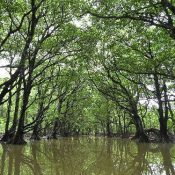
January 14, 2020 Ryukyu Shimpo
Ryota Shimabukuro
Okinawa Prefecture, which is trying to get four of their islands, Amami Oshima, Tokunoshima, the northern part of Okinawa’s main island, and Iriomote, will implement a policy that limits the number of tourists who can enter the town of Takemi on Iriomote, as part of a “master plan” to formulate sustainable tourism this year.
The limit will not be a regulation but rather a target number, and the plan is to regularly monitor entry into the island throughout the year.
Since it is expected that the number of tourists will increase with the designation as a World Natural Heritage Site, the goal is to avoid the large burden on the natural environment that would come with it.
On January 30, a regional meeting will be held for organizations concerned with Iriomote, where they will set the limit of visitors.
The International Union for Conservation of Nature and Natural Resources (IUCN) is planning on making a decision whether or not the islands become a World Natural Heritage Site this summer.
Before this happens, Okinawa hopes to formulate the master plan, translate it into English, and send it to the IUCN, in order to show them how they plan to protect the environment after the islands are registered.
Organizations such as the Nature Conservation Society of Japan have sent a written request to the IUCN asking for a recommendation for the visitor limit.
Iriomote faces problems such as the Iriomote cat, a protected species, being hit by cars, and there are some who have voiced negativity towards the expected increase in tourism that would be brought about by the island’s inclusion in the list.
This led the prefecture to settle on a visitor limit, and they have been working on building a broad consensus with the various local organizations involved with the island, as well as their cooperation toward registering the island.
In the proposed master plan, which includes the Yanbaru region, there is also a policy that would recommend a guide to accompany visitors when entering the forests in the center of the proposed heritage sites.
The goal is to attract more people to the areas around the forest, and while building enthusiasm, encouraging the accompaniment of guides to reduce the potential damage to the natural habitat, which is home to many rare species of plants and animals.
The regional meeting to decide on the visitor limit will also engage private companies such as the ferry companies, with the hopes of implementing an effective policy with the cooperation of these businesses.
(English translation by T&CT and Sam Grieb)
Go To Japanese

January 8, 2020 Ryukyu Shimpo
On January 7, the Kuroshio Biological Research Institute announced it discovered a new jellyfish species among the specimen they collected in Northern Okinawa and named it Olindias deigo (Japanese: Deigo-hanagasa-kurage).
It is the first time in 114 years a new species of the Olindias genus was discovered. The finding was published in the zoology journal, Zookeys, on December 31, 2019.
The Olindias deigo” belongs to the Olindias genus in the family Olindiidae, which is said to be the “most beautiful [jellyfish] in the world.”
The bell size of a mature Olindias deigo can reach 7-8 cm.
The Kuroshio Biological Research Institute has been collecting jellyfish specimens along the coasts of Nago City and Motobu from 2015 to 2018.
Based on morphology and DNA analysis, the Institute determined that ten of the collected specimens represent a new species.
Furthermore, the researchers observed the Olindias deigo for six months and reached an understanding of the bionomics, or life history, of the new jellyfish.
The Institute explained the Olindias deigo is named after the Okinawan deigo flower, which blooms in the spring and summer months when the jellyfish arrive.
Moreover, the deigo flower is loved by Okinawans as the prefectural flower, and the researchers hoped for the locals to feel a similar connection with the jellyfish.
(English translation by T&CT and Monica Shingaki)
Go To Japanses
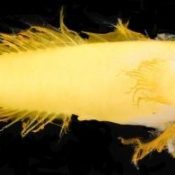
January 9, 2020 Ryukyu Shimpo
Motobu and Onna – On January 8th, it was announced that the Okinawa Churashima Foundation and Okinawa Institute of Science and Technology Graduate University (OIST) had determined that the goby specimen discovered by the foundation in the deep sea around Onna Village is the first of this goby species recorded in Japan.
Due to its yellow color, the goby species was named yuuna goby (Japanese: yuuna-haze) after the beach hibiscus, which is called yuuna in Japanese.
The yuuna goby specimen was found in August, 2017. The foundation was conducting a survey of the deep sea off the cost of Seragaki, Onna Village using a remotely operated vehicle.
The goby specimen was found in an empty carrier snail shell collected during this survey of the ocean floor at a depth of 214 meters.
The goby is 2.5 centimeters from end to end and the entire body is yellow. It only has scales at the base of its tail fin.
These characteristics distinguish it from other goby species in Japan.
The specimen died 3 months after it was found so it was analyzed. This is the seventh reported finding of this species globally, and among the seven, was discovered in the deepest water.
The results of a DNA analysis show that the yuuna goby is a close relative of the half-barred goby that lives in rock and coral reefs.
A spokesperson for the foundation says, “We want to show how fascinating marine life is by continuing to discover rare creatures through surveys conducted with remotely operated vehicles.”
(English translation by T&CT and Ellen Huntley)
Go To Japanese
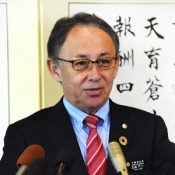
January 6, 2020 Ryukyu Shimpo
On the morning of January 6, when government offices start work, Okinawa Governor Denny Tamaki delivered a New Year’s greeting broadcast from the governor’s reception office in the Prefectural Office.
In a message to government workers, he said, “I want department heads to act centrally in carrying out our duties as public servants to all prefectural citizens, in order to realize a society in which no one is left behind”.
Governor Tamaki spoke about the U.S. base issues, saying, “Ongoing incidents due to U.S. soldiers and civilians in military employ, as well as accidents and noise issues caused by the bases are a never-ending state of affairs.
From here on, I will strongly demand that the central government abandon construction of the new base in Henoko and remove dangers as soon as possible, such as by the quick closure and return Futenma Air Station and the stopping of operations, and I will do my utmost to drastically revise the U.S.-Japan Status of Forces Agreement and to resolve the many problems that stem from the bases”.
(English translation by T&CT and Erin Jones)
Go To Japanese
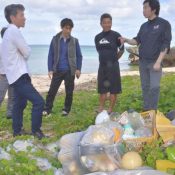
January 8, 2020 Ryukyu Shimpo
A collaboration of research teams from organizations that include private businesses, the University of the Ryukyus, and Nagasaki University launched a project to survey ocean garbage coming ashore using satellites, drones, and fixed cameras on January 7.
The team first plans on getting an understanding of how trash is drifting ashore on Okinawa and Tsushima Island in Nagasaki, and is aiming to expanding the project to effectively predict and collect ocean-based garbage on a global level.
The project plans on accomplishing this by developing a diagnostic system that can detect where garbage will come ashore by analyzing images from satellites that capture images of the coastline.
The project will use drones and set fixed cameras along the coast to confirm the presence of the garbage, and will cross reference this against the simultaneous satellite imagery to be able to better use the satellites to track ocean garbage.
The project will be led by satellite part maker Amanogi (Tokyo) CEO Hiroshi Kudo, and they have enlisted the help of a drone-making company as well.
University of the Ryukyus engineering associate professor Donshik Kang will also be involved with the satellite imagery analysis and will be in charge of the on-site resources.
On the day of the project’s launch, the members visited the coastline in Motobu, and observed fishing nets, PET bottles, and Styrofoam containers scattered along the beach.
They also visited community members engaged in cleanup efforts as well as Motobu Town Hall and the Okinawa Prefectural Office.
Kudo said, “Since we have A.I. technology that can analyze satellite imagery, we thought that we needed to put it to use in some way.
If we can determine when and where this garbage is appearing on the earth’s surface, it would be a good use of that analysis.”
The project represents one of the initiatives of “Project Ikkaku,” a collaboration of the Nippon Foundation, the Japan Advanced Science and Technology Organization for education, human-resource and research (JASTO), and Leave a Nest, which has adopted the elimination of coastline garbage as one of their three main themes.
In addition to developing the garbage processing system, the project is also developing resources to recycle and develop consumer goods with recycled plastic, of which both initiatives will engage Okinawan businesses and research organizations.
(English translation by T&CT and Sam Grieb)
Go To Japanese
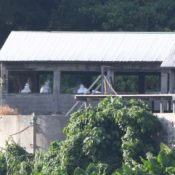
January 9, 2020 Ryukyu Shimpo
Pork dishes are indispensable to Okinawan cuisine—Okinawa soba, san-mai niku (braised pork belly), tebichi (stewed pork feet), soki-jiru (pork spare ribs soup) and mimiga (crunchy pig’s ear), to name a few.
The news of Classical Swine Fever (CSF), or hog cholera, emerging on the island for the first time in 34 years shocked many Okinawan consumers: “Pork is Okinawan culture,” “I’m hesitant to eat pork,” and “It must’ve been a lot of work raising the hogs.”
Many expressed uncertainty and concern, while others sympathized with the farmers.
A Nago City grocery store patron, Yoshimi Shimabukuro, 60, is worried: “I’m hesitant to eat [pork].
There’s an Agu (rare traditional Ryukyuan pork breed) farm near my work. I hope [the hog cholera] doesn’t spread.”
Uruma City resident Takashi Kuwae, 70, learned the news in the papers. “[Pork] is Okinawan culture.”
He added with a gloomy expression, “I’m concerned [the disease] will impact Okinawa’s livestock industry.
The prefecture needs to be swift, and prevent [it] from spreading throughout Okinawa.”
Tomiko Nakamoto, 75, taking a stroll through downtown Naha City, exclaimed “Asha-yo” (“Oh dear” in Okinawan) when she learned the news. “I use [pork] in everything—vegetable stir fry, soba.
Many Okinawan dishes use pork meat. I hope [the disease] doesn’t spread.”
Yoshitaka Ishikawa, 65, neighborhood association president of Maeda, Urasoe City, where the Okinawa Urban monorail was extended last October, said, “Pork meat is at the center of Okinawa’s food culture.
I’m worried about damaging public image among tourists. The [disease] needs to be dealt with calmly, to ward off harmful misinformation.”
(English translation by T&CT and Monica Shingaki)
Go To Japanese
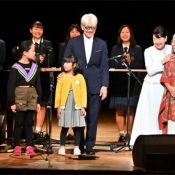
January 6, 2020 Ryukyu Shimpo
A charity concert was held on Jan. 5 by actress Sayuri Yoshinaga and musician Ryuichi Sakamoto at the Okinawa Convention Center Theater in Ginowan City.
Sakamoto’s sophisticated piano performance and Yoshinaga’s poetry reading, which spoke to the preciousness of peace, captivated the packed audience until the end.
In the first half of the concert, Sakamoto and Okinawan musician Misako Koja shared the stage.
Koja’s Uta Sanshin (Okinawan banjo and song) performance added intriguing textures to Sakamoto’s soft and gentle piano music, as the pair played Sakamoto’s 2015 piece, Miruku Yugafu – Undercooled.
The duo’s performance of the traditional Okinawan song Asadoya Yunta loosened up the audience, as the crowd clapped, chanted and whistled along.
Yoshinaga read 11 pieces of poetry in the latter half of the concert, including Peace Poem (Heiwa no Shi) written by local children.
The actress shared her thoughts on the Peace Poem and said, “People all over Japan have seen [the poetry] on TV, or heard it in on the radio.
I’m one of those people, and I’m always moved by it.”
Sakamoto played his piano in the background. He said of the concert, “I believe it’s my first time performing in Okinawa. My dream finally came true.”
The poem Exhibition Room by Hiroshi Hoshino was accompanied by somber piano music, as the actress read about the Himeyuri Peace Museum and empathized with the Himeyuri student nurses that lost their lives in the Battle of Okinawa.
Sniffles could be heard from the audience by the time Yoshinaga began reading A Pray by Kenta Hiyane.
A former Himeyuri student nurse, Yoshiko Chinen, 91, was in the audience. Chinen said, “The performance fully conveyed Yoshinaga and Sakamoto’s feelings for Okinawa.
I was touched.” Gushikami Middle School eighth-grader Shugo Uejo, 15, who took the stage to sing the Okinawan song Tinsagu nu Hana, said with a sparkle in his eyes: “I was excited to watch Ryuichi Sakamoto perform live up close. I want to be a musician like him one day.”
(English translation by T&CT and Monica Shingaki)
Go To Japanese
Satoko Oka Norimatsu
As we approach the 75th anniversary year of the end of World War II and the Asia-Pacific War, I would like to write about the war experience of two Canadian men who died this year.
One is Marius van Dijk van Nooten, who died on August 23 at age 88 in White Rock, BC.
I met him at an annual peace education symposium for high school students, about a decade ago.
Marius was born in 1930 in the Netherlands and spent his early years in Bandung, in the Dutch East Indies (now Indonesia) as his father was an officer at Royal Netherlands East Indies Army.
From December 7, 1941, Japan waged war against the United States, Great Britain, and the Netherlands, which had colonized much of Southeast Asia and the Pacific.
Its purpose was to gain resources to continue the war that had started with Japan’s invasion of Manchuria in September 1931.
Japan needed to gain access to resources in Southeast Asia, particularly oil-rich Indonesia, and to cut the supply routes to China by Western nations such as Britain and the United States.
It is often said that the war started with the Japanese “surprise attack on Pearl Harbor,” but Imperial Japan attacked Malaysia, Singapore, Hong Kong, Guam, Philippines, etc., on the same day.
It took Japan only a couple of months to conquer the Malay Peninsula, as the British forces surrendered in Singapore on February 15, 1942.
The Dutch East Indies Army also surrendered to Japan on March 9, 1942.
For the three years between then and Japan’s defeat in August 1945, an estimated 100,000 Dutch civilians were interned across Indonesia, and about 13,000 died. Marius, then 11 years old, was playing soccer when he was suddenly taken by the Kempeitai (Japanese military police) and was tortured, as he was interrogated for his connection to a Dutch woman who was allegedly engaged in resistance.
For three years after that, he was separated from family and spent time in three different concentration camps.
For Marius, every day was a fight against hunger. At one point, he chose a cookbook as his one permitted belonging, so that he could look at the recipes and imagine much better food than the watery rice that he was being fed.
That was how he kept his sanity at the concentration camps, where he slaved from age 11 to 14.
Burying the bodies of other internees who had died from beriberi and TB was just one of the things he was forced to do.
After the war, he went back to the Netherlands and immigrated to Canada in 1954. He started off as a potato peeler; then he worked his way up to be the captain of a commercial ship.
When he testified about his war-time experience, he talked merrily with a sense of humour, but, in fact, severe PTSD had started in the 1980s, forcing him to retire from his job.
Gerry Gerrard, a Canadian veteran who died on May 22 in Victoria, BC this year at age 97, was another man who spent his post-war life suffering from nightmares and flashbacks, recurring memories of war-time abuse.
When the war started, he was one of the 1,975 members of the Canadian forces sent to take part in the defense of Hong Kong.
I had an opportunity to interview him in October 2016 for a Japanese weekly journal.
In the Battle of Hong Kong that ended with the Japanese victory two weeks after its start, 260 Canadian men died, and the rest were captured. For the 3 years and 8 months after that, Gerry was put to slave labour in construction, shipbuilding, and steel manufacturing in Hong Kong and Japan.
267 more Canadian POWs died from hunger, diseases, and violence during their captivity, and those who survived, like Gerry, spent the rest of their lives with physical and mental scars, which affected their children and grandchildren.
Neither Marius nor Gerry received a sincere apology or compensation from the Japanese government.
Both men would have rather not bought Japanese products, but they both held my hands, and that was because they wanted me to tell their stories to people in Japan.
In the days leading up to the year 2020, my heart extends to those who died without ever seeing justice in their lives.
This is an English translation of the author’s article that appeared in Ryukyu Shimpo on December 29, 2019.
Satoko Oka Norimatsu is a Vancouver-based writer. She is co-author of Resistant Islands: Okinawa Confronts Japan and the United States, the 2nd edition (Rowman and Littlefield, 2018).

January 4, 2020 Ryukyu Shimpo
On the afternoon of January 3, world-renowned musician Ryuichi Sakamoto, 67, visited the sea area where a new military base is being constructed off the coast of Henoko, Nago.
“There is no justification for destroying this beautiful natural environment to build (a new base).
Don’t many people agree?
Only 1% of the soil has been filled in so far, and it’s not too late to turn back,” said Sakamoto, expressing his view that the land reclamation work should be stopped.
Sakamoto toured the land reclamation site and surrounding area in a glass boat operated by Takuma Higashionna, a councilperson on the Nago City Council.
“It is absurd that there are so many bases on this island.
I can’t help but think that there is discrimination between mainland Japan and Okinawa,” Sakamoto said with regard to the situation in which the base construction is moving forward contrary to the wishes of Okinawans.
He criticized the national government for pushing forward with the new base construction.
Sakamoto visited Henoko in advance of a charity concert to be held on January 5 where he will perform together with Sayuri Yoshinaga.
(English translation by T&CT and Sandi Aritza)
Go to Japanese










 Webcam(Kokusai Street)
Webcam(Kokusai Street)


